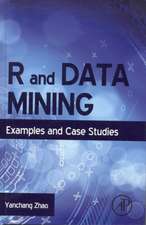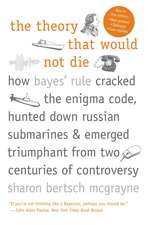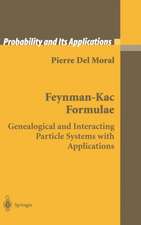Stochastic Approaches for Systems Biology
Autor Mukhtar Ullah, Olaf Wolkenhaueren Limba Engleză Paperback – oct 2014
The text contains many illustrations, examples and exercises to illustrate the ideas and methods that are introduced. Matlab code is also provided where appropriate. Additionally, the cell cycle is introduced as a more complex case study.
Senior undergraduate and graduate students in mathematics and physics as well as researchers working in the area of systems biology, bioinformatics and related areas will find this text useful.
| Toate formatele și edițiile | Preț | Express |
|---|---|---|
| Paperback (1) | 371.97 lei 38-44 zile | |
| Springer – oct 2014 | 371.97 lei 38-44 zile | |
| Hardback (1) | 397.16 lei 6-8 săpt. | |
| Springer – 15 iul 2011 | 397.16 lei 6-8 săpt. |
Preț: 371.97 lei
Nou
Puncte Express: 558
Preț estimativ în valută:
71.17€ • 74.32$ • 58.77£
71.17€ • 74.32$ • 58.77£
Carte tipărită la comandă
Livrare economică 11-17 aprilie
Preluare comenzi: 021 569.72.76
Specificații
ISBN-13: 9781489994912
ISBN-10: 1489994912
Pagini: 324
Ilustrații: XXXII, 290 p.
Dimensiuni: 155 x 235 x 17 mm
Greutate: 0.45 kg
Ediția:2011
Editura: Springer
Colecția Springer
Locul publicării:New York, NY, United States
ISBN-10: 1489994912
Pagini: 324
Ilustrații: XXXII, 290 p.
Dimensiuni: 155 x 235 x 17 mm
Greutate: 0.45 kg
Ediția:2011
Editura: Springer
Colecția Springer
Locul publicării:New York, NY, United States
Public țintă
GraduateCuprins
Preface.- Acknowledgements.- Acronyms, notation.- Matlab functions, revisited examples.- Introduction.- Biochemical reaction networks.- Randomness.- Probability and random variables.- Stochastic modeling of biochemical networks.- The 2MA approach.- The 2MA cell cycle model.- Hybrid Markov processes.- Wet-lab experiments and noise.- Glossary
Notă biografică
Olaf Wolkenhauer received his first degrees in control engineering from the University of Applied Sciences in Hamburg, Germany and the University of Portsmouth in the U.K. He obtained his PhD from the University of Manchester, Institute of Science & Technology (UMIST) for research on the application of possibility theory to data analysis. Following a research lectureship at the Control Systems Centre at UMIST and a research fellowship at the Technical University Delft in the Netherlands, he directed his research towards systems biology. This led to a joint senior lectureship with the Dept. of Biomolecular Sciences and the Dept. of Electrical Engineering and Electronics, at UMIST. In 2003 he moved to the University of Rostock in Germany, where he heads the Department of Systems Biology and Bioinformatics. He is a fellow of the Stellenbosch Institute for Advanced Study (STIAS). Olaf Wolkenhauer’s research interests are in mathematical modelling and data analysis. His work concentrates on a systems-theoretic approach to understand the regulation, control and coordination of complex dynamical systems.
Webpage: www.sbi.uni-rostock.de
Mukhtar Ullah received his BSc in Electrical Engineering from N-W.F.P University of Engineering and Technology Peshawar, N-W.F.P, Pakistan. He completed his MSc. in Advanced Control and Systems Engineering from the Department of Electrical Engineering and Electronics, at the University of Manchester Institute of Science and Technology (UMIST), Manchester, U.K. in 2002. In 2003 he moved to the University of Rostock in Germany as a research assistant in the Department of Systems Biology andBioinformatics in the Institute of Computer Science. In 2009 he completed his PhD from the same department. He is currently working as a post-doctoral research associate in the same department. His research focuses on stochastic modelling of biological systems.
Webpage: www.sbi.uni-rostock.de
Webpage: www.sbi.uni-rostock.de
Mukhtar Ullah received his BSc in Electrical Engineering from N-W.F.P University of Engineering and Technology Peshawar, N-W.F.P, Pakistan. He completed his MSc. in Advanced Control and Systems Engineering from the Department of Electrical Engineering and Electronics, at the University of Manchester Institute of Science and Technology (UMIST), Manchester, U.K. in 2002. In 2003 he moved to the University of Rostock in Germany as a research assistant in the Department of Systems Biology andBioinformatics in the Institute of Computer Science. In 2009 he completed his PhD from the same department. He is currently working as a post-doctoral research associate in the same department. His research focuses on stochastic modelling of biological systems.
Webpage: www.sbi.uni-rostock.de
Textul de pe ultima copertă
This textbook focuses on stochastic modelling and its applications in systems biology. In addition to a review of probability theory, the authors introduce key concepts, including those of stochastic process, Markov property, and transition probability, side by side with notions of biochemical reaction networks. This leads to an intuitive presentation guided by a series of biological examples that are revisited throughout the text. The text shows how the notion of propensity, the chemical master equation and the stochastic simulation algorithm arise as consequences of the Markov property. The nontrivial relationships between various stochastic approaches are derived and illustrated. The text contains many illustrations, examples and exercises to communicate methods and analyses. Matlab code to simulate cellular systems is also provided where appropriate and the reader is encouraged to experiment with the examples and case studies provided. Senior undergraduate and graduate students in applied mathematics, the engineering and physical sciences as well as researchers working in the areas of systems biology, theoretical and computational biology will find this text useful.
Caracteristici
Focuses on both analytical and numerical approaches Key Concepts in Stochastic Processes Matlab examples provided Many illustrations and examples included Includes supplementary material: sn.pub/extras













